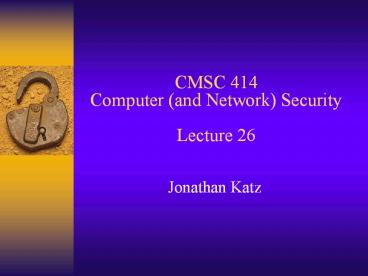CMSC 414 Computer and Network Security Lecture 26 - PowerPoint PPT Presentation
1 / 14
Title:
CMSC 414 Computer and Network Security Lecture 26
Description:
SSL runs on top of TCP, in a user-level process. Recall, does not ... Using TCP rather than UDP simplifies things. Recall, this opens a potential DoS attack ... – PowerPoint PPT presentation
Number of Views:75
Avg rating:3.0/5.0
Title: CMSC 414 Computer and Network Security Lecture 26
1
CMSC 414Computer (and Network) SecurityLecture
26
- Jonathan Katz
2
SSL/TLS
3
Brief history
- SSLv2 deployed in Netscape 1.1 (1995)
- Microsoft improved upon it
- Netscape deployed SSLv3
- Most commonly deployed
- IETF introduced TLS
- Similar, but incompatible
- Here, we just say SSL!
4
Broad overview
- SSL runs on top of TCP, in a user-level process
- Recall, does not require changes to the OS
- Using TCP rather than UDP simplifies things
- Recall, this opens a potential DoS attack
5
Basic protocol flow
- Alice (client) sends hello, supported crypto,
and nonce RA - Bob (server) sends a certificate, selects crypto,
and sends nonce RB - Alice encrypts S with Bobs public key
- Alice/Bob derive key(s) from RA, RB, S
- Must be careful about which encryption scheme is
used!
6
Basic flow, continued
- They each authenticate the initial handshake
using the shared key(s) - The keys are used to encrypt/authenticate all
subsequent communication - Separate keys shared for encryption and
authentication in each direction - Also for IVs (but this is a flaw!)
- Sequence numbers used to prevent replay
7
Note
- As described, SSL only provides one-way
authentication (server-to-client) - Not generally common for clients to have public
keys - Can do mutual authentication over SSL using,
e.g., a password - SSL also allows for clients to have public keys
8
Session resumption
- Because it was designed with http traffic in
mind, one session can be used to derive many
secure connections - Server assigns a session_id and stores that along
with the session key - Connection keys can be derived from the session
key (assumes the client remembers it) and fresh
nonces - Can always re-derive a session key (expensive!)
9
Some attacks (and fixes)
- Man-in-the-middle can downgrade the acceptable
crypto in Alices first message - One of the problems with negotiating crypto
- Fixed by authenticating handshake phase
- An adversary could also close a connection early
(TCP close_connection_request was not
integrity-protected) - Fixed by adding finish message which is
authenticated
10
PGP
11
Overview
- There are many schemes for secure email
- PGP is popular for a number of reasons
- one of which is its PKI model (i.e., the web of
trust)
12
Overview
- PGP provides for both encryption and digital
signatures - Encryption
- Standard techniques
- Multiple recipients handled efficiently
- Signatures
- Again, standard techniques
13
Web of trust
- Anarchy model
- User defined level of trust in any signature /
principal - Can be simplified somewhat if the user chooses to
do so
14
Summary of course































